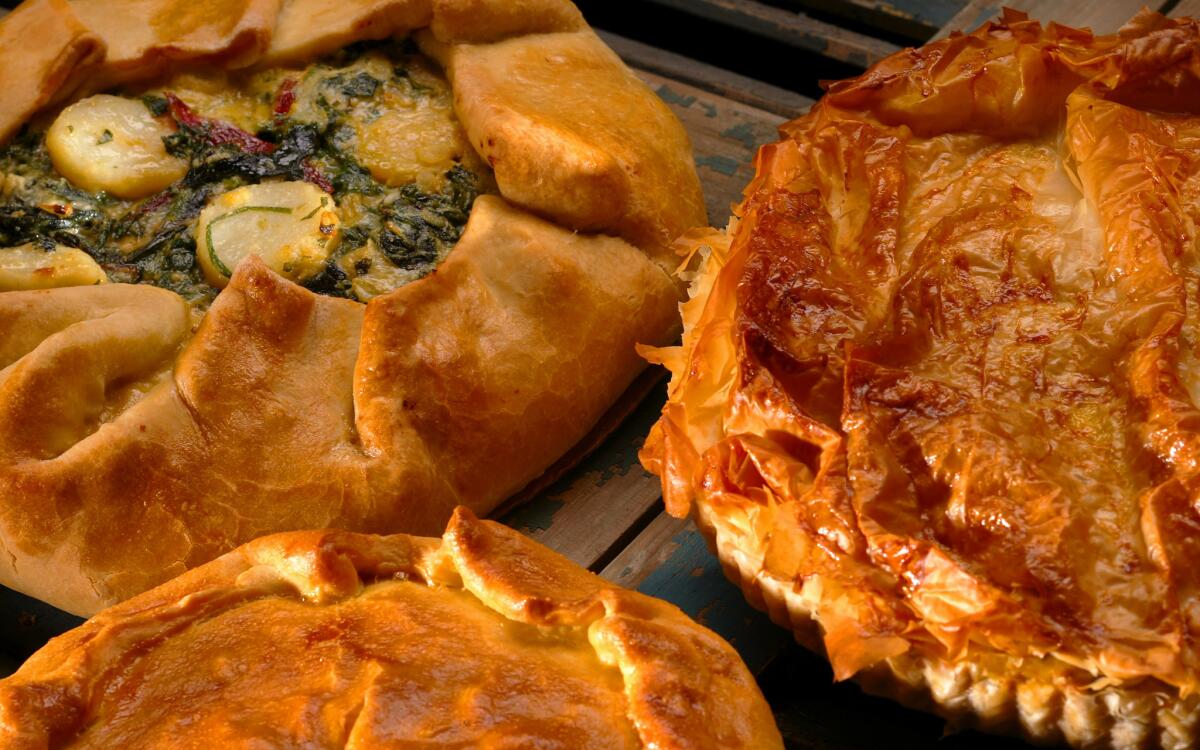Provencal pumpkin torte

The noted French chef Careme pronounced the vegetable torte well and truly dead by the first part of the 19th century.
“Tortes are no longer fancy enough to appear on our opulent tables, for the simple reason that their form is too vulgar,” he wrote in “Treatise on Hot Entrees.” “Even the bourgeois class looks upon them with disdain, and will only eat hot pates and vol-au-vents, whereas in the past, important people were happy to begin their home-cooked meal with a modest torte.”
He may have jumped the gun. I don’t think I’ve ever gone to a Mediterranean country--France or anyplace else--and not come home with a new recipe for one of these savory pies.
Throughout the Mediterranean you find variations. Usually, they’re based on the same vegetable themes--greens of all kinds, winter or summer squash, leeks, eggplant, onions. What really distinguishes one country’s pies from another are the fine points, the flavorings, the cheeses and the crusts.
A winter squash torte from Provence, earthy with sage and surrounded by a bready olive oil crust, would never be mistaken for a Greek pumpkin torte, the filling redolent with mint and leeks, set between layers of crisp filo dough.
At the same time, a Greek pie of spinach or bitter greens will be fragrant with dill and packed with feta cheese, while its French or Italian cousin will have a more moderate amount of Gruyere and/or Parmesan, as well as garlic, thyme, rosemary and parsley.
Tortes take a little bit of time to make, but they are forgiving. And you can make them in steps. The order in which you do things isn’t that important--you can make part or all of a filling one day, and the crust another (or vice versa), and put it all together when you’re ready to bake.
Because they keep so well, they also can be made ahead, or frozen. If you do the whole thing, from start to finish, you’ll be working for about an hour, but none of the work will be that difficult. The yeasted olive oil crust is about the easiest pastry I’ve ever made.
Best of all, they’re big, dramatic and versatile. You can make them in a tart or springform pan, as a double-crusted torte, or you can make a more open-faced galette and bake it on a cookie sheet. They are meant to be served as a main dish, and they’re good hot or cold.
Tortes make great party fare, but they’re also a wonderful meal for the family; and leftovers pack easily into a lunchbox. This is one way I can get my 3 1/2-year-old to eat spinach. Of course, he hasn’t read Careme yet.
Halve the squash and scrape away the seeds and membranes, then cut the flesh into 4-inch-square pieces. (If using butternut, cut it in half crosswise, just above the bulbous bottom part, then cut these halves into lengthwise quarters and scrape away the seeds and membranes.)
Steam the squash until tender, 15 to 20 minutes, then transfer to a colander and allow to cool and drain for another 15 minutes (butternut squash will not be watery). When the squash has cooled, peel and place in a bowl. Mash with a fork, a large wooden spoon, a potato masher or a pestle.
Heat the oil over medium heat in a large nonstick skillet and add the onion. Cook, stirring, until tender, about 5 minutes, then stir in the garlic. Cook until fragrant, another minute or two. Remove from the heat and toss with the squash, sage, rice, parsley, Gruyere and Parmesan cheeses, all but 2 tablespoons of the eggs, salt and pepper to taste. Taste and adjust seasonings.
Heat the oven to 375 degrees. Oil a 10-inch or 12-inch tart pan with a removable bottom or springform pan.
Roll out two thirds of the pastry and line the pan with the edges overhanging. Fill the crust with the squash mixture. Top with the remaining pastry, then crimp the edges of the top and bottom pastry together. Cut 4 small slits in the top crust with a sharp knife, brush with the reserved beaten egg and place in the oven. Bake until golden brown, 45 to 50 minutes. Allow to rest for at least 10 minutes before serving. This can also be served at room temperature.
Get our Cooking newsletter.
Your roundup of inspiring recipes and kitchen tricks.
You may occasionally receive promotional content from the Los Angeles Times.















